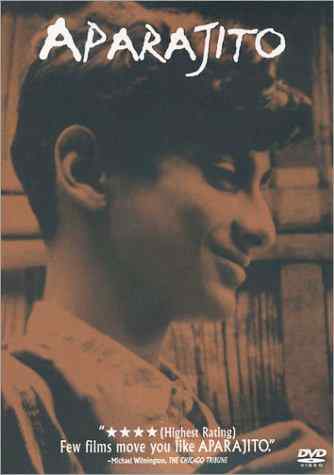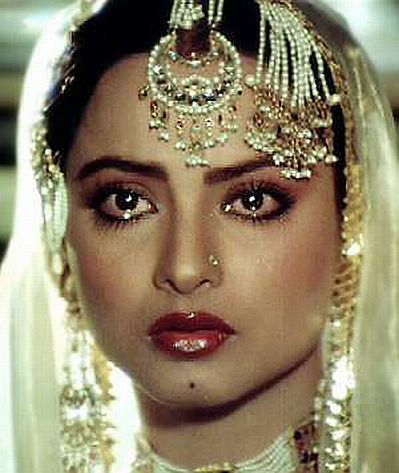 While Pather Panchali never leaves the village, Aparajito is constantly on the move as Apu grows up and becomes restless for new experience. Set in the 1920s, the film opens in the holy city of Benares on the Ganges, where the family has moved after Durga’s death. Though poor, they seem relatively happy – Harihar earns his livelihood as a priest, reciting Hindu scriptures on the banks of the holy river Ganges, and Apu has found new friends. Ray, who often compared Benares to Venice, paints a visual collage of this ancient Indian city, with its bathing ghats, priests, wrestlers, festival fireworks.
While Pather Panchali never leaves the village, Aparajito is constantly on the move as Apu grows up and becomes restless for new experience. Set in the 1920s, the film opens in the holy city of Benares on the Ganges, where the family has moved after Durga’s death. Though poor, they seem relatively happy – Harihar earns his livelihood as a priest, reciting Hindu scriptures on the banks of the holy river Ganges, and Apu has found new friends. Ray, who often compared Benares to Venice, paints a visual collage of this ancient Indian city, with its bathing ghats, priests, wrestlers, festival fireworks.Aparajito is based on the second half of Bibhutibhushan Bandopadhyay’s novel Pather Panchali and the first half of his novel Aparajito. While translating Bandopadhyay’s popular Bengali novel into a cinematic text, Ray eliminated numerous characters and episodes. For Ray, books were not primarily written to be filmed – “If they were, they would read like scenarios; and, if they were good scenarios, they would probably read as bad literature.” The documentary elements and visual passages of Pather Panchali was subordinated by studio sets and Ray’s decision to concentrate on the relationship between the widowed Sarbojaya and her son, and their gradual estrangement.
After Harihar’s death, mother and son return to the village and live in their uncle’s house – a situation reminiscent of Ray’s own life, where he lived in his uncle’s house for twenty years after his father’s early death. Though he prepares himself for the vocation of his father and forefathers, Apu is already lost to a traditional way of life. There is pathos in Apu’s efforts to learn the priestly rituals when all he desires is to run off and play with the other boys, and go to school. However, it is at this point that the narrative of Apu evolves into that of a boy who must script his own destiny, and venture outside the microcosmic world of the village and its environs. The transformation that comes to Apu with adolescence becomes intensified when Pinaki Sengupta, as the boy Apu, is replaced by Smaran Ghosal as the youth Apu who captures the interest of his teacher, a stark contrast to the grocer-teacher played by Tulsi Chakraborty in Pather Panchali. However, Apu’s quest for knowledge and his desire to explore the world beyond the village alienates him from his mother, who wants him to continue in the tradition of his ancestors and become a village priest. Sarbojaya, with her half-hearted enthusiasm for Apu’s dreams, ceases to hold interest for him, and he, unconsciously, pays less and less attention to her wishes.
For Pather Panchali, the entire camera work was executed with direct sources of light – natural light for the daytime sequences and direct studio lighting for the night scenes. With Aparajito, Ray and his cinematographer, Subrata Mitra, began experimenting with the reflected light, which they continued to explore in subsequent films, including Ray’s first color film, Kanchenjunga.
In one of the scenes from Aparajito, as Sarbojaya stands waiting for Apu, she sees a group of fireflies swirling by the pond. Filming of this scene posed a technical challenge, as even the fastest available film stock could not capture the light emitted by the fireflies. Ray and his crew overcame the problem with an indigenous solution. Ray recounts in his ‘My Years With Apu’- We chose the toughest members of our crew, had them dressed up in black shirt and trousers and let each of them carry a flashlight bulb and a length of wire and a battery. The bulbs were held aloft in their right hands while they illustrated the swirling movements of fireflies in a dance, alternately connecting and disconnecting the wire to the bulbs."
Aparajito was not commercially successful in Bengal, unlike its predecessor – probably because Apu was not the archetypal Bengali son and the treatment of the mother-son relationship was devoid of the conventional norms. Aparajito seems to have upset the Bengali middle class, Ray’s primary audience and the people he had grown up with. The film failed in Calcutta, with reviewers comparing it unfavorably with Pather Panchali. This came as a shock to Ray, who regarded Aparajito as considerably more mature than his first work. Due to the film’s unenthusiastic reception in Bengal the State did not even consider entering it for the National Awards.
In spite of the laurels for Pather Panchali, Ray did not feel he had truly arrived in the international scene until Aparajito won the Golden Lion at Venice in 1957. It had been a British member of the jury, Penelope Houston who wanted Ray to win. After much argument, the chairman Rene Clair acquiesced with good grace; but on the boat back from their meeting place to the awards ceremony, Houston recalls Clair saying to her, without a trace of malice towards Ray, “But now I hope Ray will go away and learn how to make films.”
Apart from the Golden Lion at Venice, Aparajito also won many other awards – Cinema Nuovo Award, Venice, 1957; Critics' Award, Venice, 1957; FIPRESCI Award, London, 1957; Best Film and Best Direction, San Francisco, 1958; International Critic's Award, San Francisco, 1958; Golden Laurel for Best Foreign Film of 1958-59, USA; Selznik Golden Laurel, Berlin, 1960; Bodil Award: Best Non-European Film of the Year, Denmark, 1967




No comments:
Post a Comment